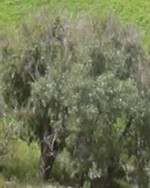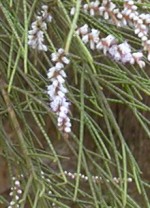 This evergreen tree is a native of northern and central Africa, the Middle East, and parts of Asia where it is found growing along water courses. It is a member of the Tamaricaceae, a small family of 78 species. The tiny scale-like leaves are closely packed on slender branchlets so that the tree looks like a pine giving it an alternate common name of Athel pine. It is not related to pines, however, and is a flowering plant. The leaves exude salt and can make the soil below so salty that other plants can not grow there. The flowers are small, pinkish white, and borne in spikes from spring until summer, but in some places throughout the year. They serve as a significant pollen source for the European honeybee. The bell shaped fruits have hairy tufts and contain tufted seeds that are often sterile. The trunk can reach 2.5’ in diameter and has thick, tough, dark gray bark when mature. The root is a very deep tap root, making the tree difficult to transplant. Athel tamarix makes a good wind barrier in dry regions and are planted as ornamentals in Southern California. They can be used as a fire barrier because they resist burning due to their high salt and ash content. So far, they have not become invasive as several other species of tamarix have but their ability to hybridize with these species may lead to problems in the future. The genus name, Tamarix, is derived from the Tamaris River in Spain. The specific epithet, aphylla, comes from the Greek a- , meaning lacking, and phylla, meaning leaf, referring to leafless look of the branches. The specific epithet, articulata, is the Latin word meaning jointed.
This evergreen tree is a native of northern and central Africa, the Middle East, and parts of Asia where it is found growing along water courses. It is a member of the Tamaricaceae, a small family of 78 species. The tiny scale-like leaves are closely packed on slender branchlets so that the tree looks like a pine giving it an alternate common name of Athel pine. It is not related to pines, however, and is a flowering plant. The leaves exude salt and can make the soil below so salty that other plants can not grow there. The flowers are small, pinkish white, and borne in spikes from spring until summer, but in some places throughout the year. They serve as a significant pollen source for the European honeybee. The bell shaped fruits have hairy tufts and contain tufted seeds that are often sterile. The trunk can reach 2.5’ in diameter and has thick, tough, dark gray bark when mature. The root is a very deep tap root, making the tree difficult to transplant. Athel tamarix makes a good wind barrier in dry regions and are planted as ornamentals in Southern California. They can be used as a fire barrier because they resist burning due to their high salt and ash content. So far, they have not become invasive as several other species of tamarix have but their ability to hybridize with these species may lead to problems in the future. The genus name, Tamarix, is derived from the Tamaris River in Spain. The specific epithet, aphylla, comes from the Greek a- , meaning lacking, and phylla, meaning leaf, referring to leafless look of the branches. The specific epithet, articulata, is the Latin word meaning jointed.
Type: Evergreen tree
Outstanding Feature: Salt, drought, and fire tolerance
Form: Irregular
Growth Rate: Fast
 Bloom: Small pinkish white flowers are produced in dense racemes from spring through summer; in some places trees may bloom throughout the year.
Bloom: Small pinkish white flowers are produced in dense racemes from spring through summer; in some places trees may bloom throughout the year.
Size: 30- 60’ H x 30-60’ W
Light: Full sun
Soil: Infertile, dry; tolerant of drought, salt, and alkaline conditions.
Hardiness: Zones 8-10
Care: Opening up canopy by pruning to improve the air flow will prevent the development of a weak shrubby form.
Pests and Diseases: Susceptible to mites, galls, and moths
Propagation: Seed, division of sprouts; broken limbs can produce roots.
